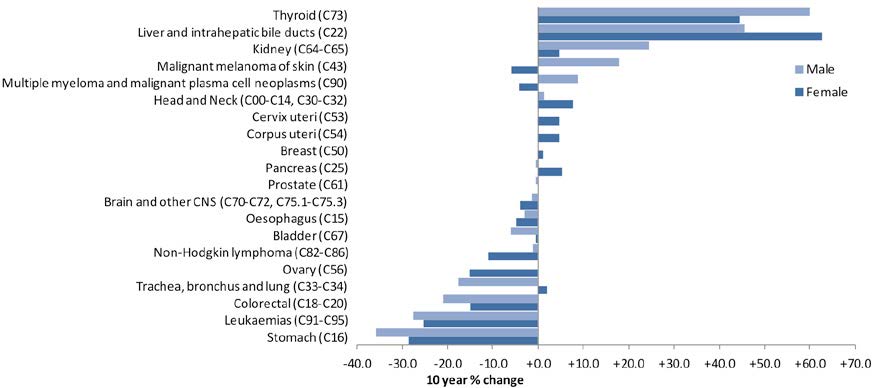
Cancer incidence in the past 10 years

01 Nov 19 |
Gavin Clark, Information Services Division, NHS National Service Scotland
Cancer prevention in Scotland has faced many challenges but had several successes during the last decade. Figure 1 summarises the change in incidence over this time frame for some of the common cancers. Further information is available in the latest ISD report on incidence and prevalence.
Within the data, there are a number of positive cancer prevention stories, including:
• The single largest risk factor for lung cancer is cigarette smoking and the large decrease (by 18%) in lung cancer in men reflects decreases in smoking prevalence over several decades. Previous smoking patterns in women mean that the drop in lung cancer incidence has not yet been seen – but is expected to follow the observed decrease in men in the next decade or two. Occupational and domestic exposures to asbestos and ionising radiation are also risk factors for lung cancer but exposure to these factors is falling and this is also contributing to the reduction seen for men.
• Over half of bowel cancers are preventable in the UK, with eating processed meat, being overweight or obese, alcohol and smoking being among the commonest risk factors. However, the decreases in men and women of 21% and 15%, respectively, in the past decade are likely to reflect reductions in smoking as well as the removal of pre-malignant polyps at colonoscopies resulting from the Scottish Bowel Screening Programme, and a further reduction would be possible if people were to address their diet and lifestyle.
In contrast, there are emerging areas of concern where modification of behaviour could make a significant difference:
• Malignant melanoma of the skin is the fifth most common cancer in both women and men. Incidence rates increased over the last decade by 18% in males and while they did not change significantly in females over the past decade, substantial increases have occurred previously.
The primary recognised risk factor for melanoma of the skin is exposure to natural and artificial sunlight, especially but not exclusively at a young age. Being safe in the sun, using suncream and avoiding sunbeds would help to reduce the risk of developing this disease further. Males are more likely to be diagnosed with melanoma on their trunk, while women are more likely to be diagnosed on their arms and legs, partly linked to occupation and which parts of the body are exposed to the sun more generally.
• About half of liver cancers are preventable in the UK, with being overweight or obese, smoking, having infections and drinking alcohol being among the commonest causes. Total units of alcohol consumed per week fell in Scotland between 2003 and 2013, and units consumed on heaviest drinking day also fell in this time, although both have changed little in more recent years. In contrast, the prevalence of overweight and obesity has persisted and there is evidence that obesity makes alcohol more damaging to the liver.
In summary, cancer incidence is dynamic, and there have been both some large increases and decreases over the past decade. This highlights the need for vigilance, routine monitoring and surveillance of cancer incidence trends, with corresponding introduction of new initiatives to
continue to tackle cancer. Various preventive interventions have had a positive impact and should be celebrated. However there are emerging cancers of concern where further intervention should have an impact and it is important that these areas get the focus that they need.
Figure 1 – 10 year percentage change in age-adjusted incidence rate for 20 most common cancers in Scotland, 2007 to 2017.
Source: Scottish Cancer Registry